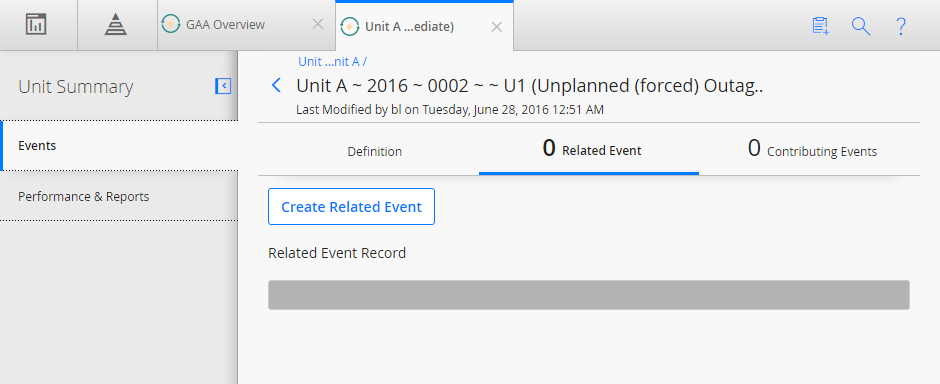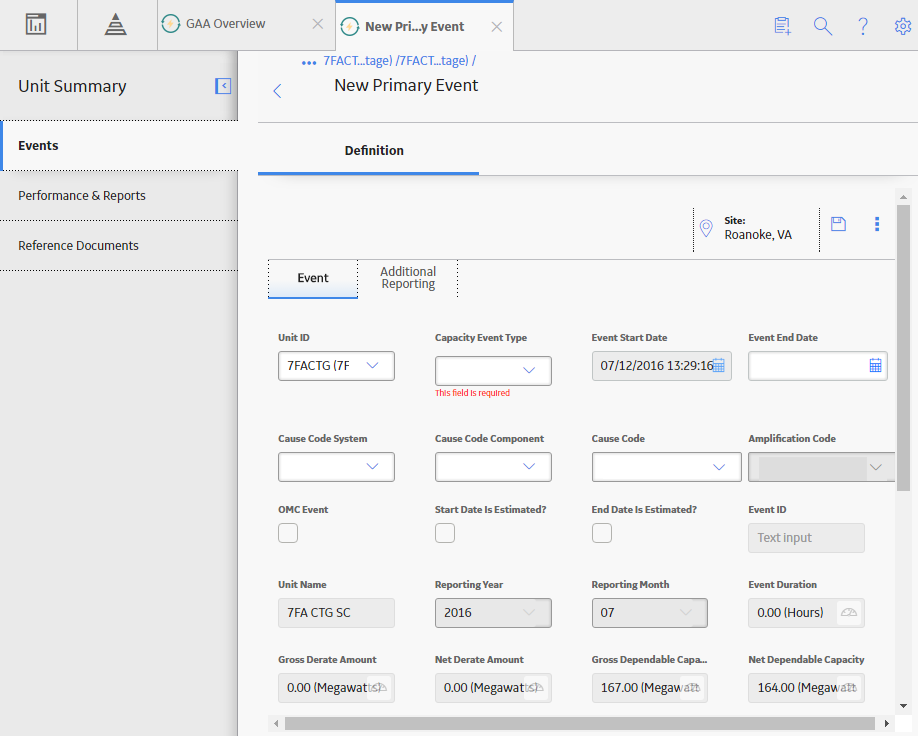Consider an example of GAA Unit A, represented by the GAA Unit record GAA Unit A. On January 3, 2016, GAA Unit A suffered an unplanned outage due to an external influence and had to be repaired before it could be used again. Repairs began at 9:00 A.M. on January 5 and continued until 5:00 P.M., when it was determined that a new part had to be ordered to complete the repairs. The new part arrived on January 8, and the repairs were finished by 5:00 P.M. on January 8.
In this scenario, you would have needed to create three Primary Events:
- One to capture the initial outage.
- One to capture the maintenance.
- One to capture the extended maintenance due to other circumstances.
Consider the following table, where each column represents an Event that you would have created in this scenario.
| Fields |
Primary Event 1 |
Primary Event 2 |
Primary Event 3 |
| Capacity Event Type
|
U1 (Unplanned (forced) Outage - Immediate)
|
MO (Maintenance Outage)
|
ME (Maintenance Outage Extension)
|
| Event Start Date
|
January 3, 2016, 9:00 A.M.
|
January 5, 2016, 9:00 A.M.
|
January 5, 2016, 5:00 P.M.
|
| Event End Date
|
January 5, 2016, 9:00 A.M.
|
January 5, 2016, 5:00 P.M.
|
January 8, 2016, 5:00 P.M.
|
In this example, you would have created two sequential Primary Event pairs:
- Pair 1: Primary Event 1 + Primary Event 2.
- Pair 2: Primary Event 2 + Primary Event 3.
None of these Primary Events can stand alone because none of them describes completely what happened to GAA Unit A.
- Primary Event 1 indicates that the unit was out during the time between when it stopped producing power and repairs began. By itself, it would not indicate that any repairs were attempted on the unit.
- Primary Event 2 indicates that repairs on the unit began at 9:00 A.M. on January 5, 2016 and ended at 5:00 P.M. the same day. By itself, it neither indicates that the unit had stopped producing power before the repairs began nor that maintenance was extended to account for the time it takes to order and receive a new part. The Capacity Event Type value for Primary Event 2 is MO, which is a valid event type for subsequent events of type U1, as defined in Primary Event 1.
- Primary Event 3 indicates that maintenance was extended but does not indicate when repairs began on the unit or that it had stopped producing power before the repairs began. The Capacity Event Type value for Primary Event 3 is ME, which is a valid event type for subsequent events of type MO, as defined in Primary Event 2.
Note: The event type ME is not valid when the event type of the preceding event is U1. But because valid event type for subsequent event are determined only by the immediately preceding event, the event type of the first event is not considered when determining allowable event types for the third event.

